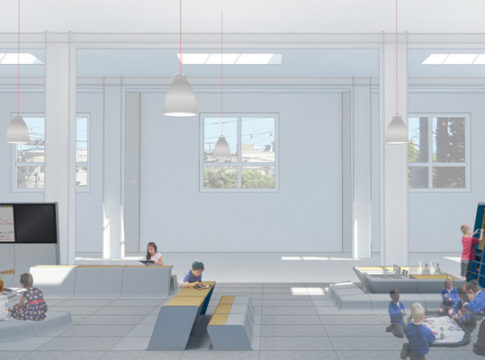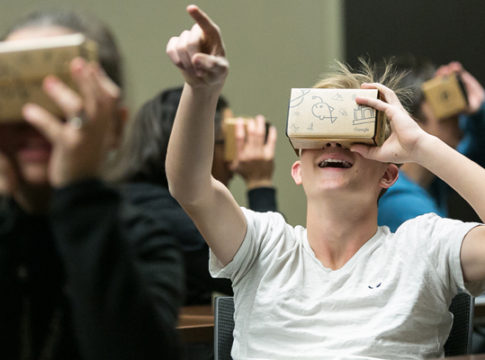If 2012 was the year of MOOCs (massive open online courses) in higher education, then the flipped classroom was the innovation of the year for K–12 schools (see “The Flipped Classroom,” what next, Winter 2012).
Both the New York Times and the Washington Post spilled ink over the phenomenon. Several authors resorted to old-fashioned books to discuss flipping, including the two teachers who allegedly originated the technique (see Flip Your Classroom: Reach Every Student in Every Class Every Day by Jonathan Bergmann and Aaron Sams). None of that tells us anything about the number of teachers who actually flipped their classrooms. No one has offered any firm measure of the practice or, more importantly, assessed its impact on student learning.
In case you missed all the hype, the flipped classroom is a form of blended learning in which students learn online at least part of the time while attending a brick-and-mortar school. Either at home or during a homework period at school, students view lessons and lectures online. Time in the classroom, previously reserved for teacher instruction, is spent on what we used to call homework, with teacher assistance as needed.
How can this improve student learning? Homework and lecture time have merely been switched. Students still learn through a lecture. And many online lectures are primitive videos.
There is some truth in this characterization, but it misses the key insight behind the flipped classroom. If some students don’t understand what is presented in a real-time classroom lecture, it’s too bad for them. The teacher must barrel on to pace the lesson for the class as a whole, which often means going too slow for some and too fast for others.
Moving the delivery of basic content instruction online gives students the opportunity to hit rewind and view again a section they don’t understand or fast-forward through material they have already mastered. Students decide what to watch and when, which, theoretically at least, gives them greater ownership over their learning.
Viewing lectures online may not seem to differ much from the traditional homework reading assignment, but there is at least one critical difference: Classroom time is no longer spent taking in raw content, a largely passive process. Instead, while at school, students do practice problems, discuss issues, or work on specific projects. The classroom becomes an interactive environment that engages students more directly in their education.
In the flipped classroom, the teacher is available to guide students as they apply what they have learned online. One of the drawbacks of traditional homework is that students don’t receive meaningful feedback on their work while they are doing it; they may have no opportunity to relearn concepts they struggled to master. With a teacher present to answer questions and watch over how students are doing, the feedback cycle has greater potential to bolster student learning.
The flipped classroom does not address all the limitations of the brick-and-mortar school. Although in the best flipped-classroom implementations, each student can move at her own pace and view lessons at home that meet her individual needs rather than those of the entire class, most flipped classrooms do not operate this way. As Salman Khan, the media’s personification of the flipped-classroom, observes in The One World Schoolhouse, “Although it makes class time more interactive and lectures more independent, the ‘flipped classroom’ still has students moving together in age-based cohorts at roughly the same pace, with snapshot exams that are used more to label students than address their weaknesses” (see “To YouTube and Beyond,” book reviews, Summer 2013).
This arrangement also doesn’t tackle the root causes of the lack of motivation that persists among many low-achieving students.
Some in the media have suggested that the flipped-classroom approach may only work in upper-income, suburban schools. If low-income students lack access to computers at home or to reliable Internet access, flipping may be a nonstarter in some schools. If students can’t benefit from online instruction at home, then they need to receive instruction in the classroom or risk falling behind. Some fear that in relying on parents to provide technology and support, the flipped-classroom model may exacerbate existing resource inequalities. Schools can make computer labs available during afterschool hours, however, and parental assistance is less critical when watching an online video than when solving homework problems.
What is perhaps most telling is that the “no-excuses” charter schools that serve large numbers of low-income students well—KIPP, Rocketship, Alliance, and Summit among them—are not flipping their classrooms. Even as these schools adopt blended-learning models, the flipped classroom isn’t among them. The models these schools are employing give students more support as they need it and actively guide students to more ownership over their learning. These models also do not rely on students having access to high-speed Internet-connected computers at home; online learning occurs during the school day.
Even if the flipped classroom does prove of some benefit to some low-income students, this change in structure alone is unlikely to produce the vast improvement in student learning our country needs. But that doesn’t mean the innovation is insignificant. The flipped classroom might still have an important indirect impact on the American education system, as one brand of digital learning. The optimal use of digital learning will vary in different contexts and communities. Some people will attend full-time virtual schools, with even the “classroom” experience occurring online; most will attend brick-and-mortar schools that employ some version of digital learning.
Unlike school vouchers for low-income students, charter schools in disadvantaged communities, or bonus pay for teachers in inner-city schools, digital learning is not designed for just one slice of the population. It’s not a policy that parents might support in theory but, because it has no practical impact on them, won’t spend political energy promoting or defending. Rather, if it works as well as its proponents hope, digital learning will gather political support from a wide swath of the American public.
And it may well turn out that the flipped classroom is most effective in private schools or upper-income suburban schools. If that’s how those students make the best use of digital learning, that’s OK. As Khan says, “Blue jeans didn’t become cool until Hollywood started wearing them.” In the world of digital learning, the flipped classroom may just be one good brand.
This article appeared in the Summer 2013 issue of Education Next. Suggested citation format:
Horn, M. (2013). The Transformational Potential of Flipped Classrooms: Different strokes for different folks. Education Next, 13(3), 78-79.





